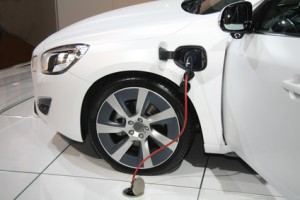30A vs 40A vs 50A EV Chargers: What Seattle Homeowners Should Know

If you are deciding between a 30A, 40A, or 50A Level 2 charger, you are not alone. Seattle drivers in Ballard, West Seattle, Capitol Hill, and Queen Anne ask this every week because the right choice depends on your car, your home, and your routine.
The short answer is that higher amps mean more speed, but not every home or lifestyle needs the maximum. If you want expert help and a safe install, our EV charger installation team at Seattle Electricians Today can size and set up the best fit for your home.
How EV Charger Amps Affect Speed And Convenience
Amps describe how much current a charger can deliver. With a 240-volt Level 2 setup, more amps generally equal more kilowatts, which means more miles added per hour.
Because every EV and battery is different, real speeds vary. As a simple way to picture it, many drivers see roughly 3 to 4 miles of range per kilowatt-hour in mild weather. That means a 30A charger can often feel plenty fast for an overnight charge, while a 50A unit shines when you get home late and need to leave early the next morning.
- 30A Level 2: often around 7 kW of power, good for steady overnight charging.
- 40A Level 2: often around 9 to 10 kW, a flexible middle ground for larger batteries or tighter schedules.
- 50A Level 2: can reach 11 to 12 kW on compatible setups, helpful for big batteries or short charging windows.
Cold mornings on the commute or preconditioning the cabin can reduce charging efficiency. That is normal in Seattle’s damp, cool seasons.
30A, 40A, And 50A: What They Mean For Real Life
30A: Reliable Overnight Charging For Most Drivers
For many households with one EV, a 30A charger refills the battery between dinner and sunrise. If you drive 20 to 40 miles a day around the city, park every night, and rarely arrive home nearly empty, 30A is often a wise, budget-friendly choice that keeps things simple.
It also puts less demand on older panels that are common in craftsman and mid-century homes from Greenwood to Beacon Hill. If you plan to add a second EV soon, you can start with 30A and reassess after a few months of real-world use.
40A: A Flexible Middle Ground For Busy Households
A 40A charger makes sense if you have a larger battery, share one charger between two drivers, or often arrive home later in the evening. It trims several hours off a deep recharge compared to 30A, which can be the difference between a full battery and a partial one before the morning school run.
Many Seattle homeowners choose 40A as a future-friendly balance. It pairs well with typical daily driving patterns in neighborhoods like Ballard or Ravenna, where street parking is tight and charging time matters.
50A: Maximum Speed When You Need It
A 50A charger helps when you have frequent long trips, limited charging windows, or a very large battery. Think weekend hikes in the Cascades, early ferry runs, or towing with an electric SUV. If you pull in late and need a big boost before dawn, the extra power can save the day.
Just remember that the fastest option is not always necessary for every home. Your vehicle also needs to accept higher charge rates to see the full benefit.
Home Electrical Factors In Seattle Homes
Every installation starts with a quick look at your electrical system. The charger size you choose should fit the home, not fight it.
- Service panel capacity: Many older homes near Wallingford and Leschi were built long before EVs. Your electrician will confirm space and available capacity.
- Circuit distance and route: Long wire runs to detached garages in Rainier Valley or West Seattle can influence the plan and what makes practical sense.
- Parking setup: Alley garages, carports, or tight driveways could shape charger location and conduit routing.
- Future projects: If you are planning a kitchen upgrade, heat pump, or hot tub, it is smart to think ahead so everything plays nicely together.
If you prefer one trusted team for whole-home upgrades, explore our residential electrical services for a broader picture of what is possible.
Safety first: avoid using portable cords or adapters as a long-term solution for EV charging. A dedicated 240-volt circuit installed by a licensed electrician reduces heat, wear, and risk while delivering steady charging performance.
Weather, Battery Size, And Daily Miles
Seattle’s cool, wet winters and mild summers affect charging behavior. On colder days, your car may spend part of the session warming the battery to an ideal temperature, which can slow the start. Larger batteries take longer to refill, and driving habits like highway speeds on I‑5 or steep climbs in Queen Anne can change how much energy you need overnight.
Here is a helpful way to think about it: your ideal amp level should cover your typical daily miles with a buffer. If you often do short city trips, 30A is usually enough. If you return home low after soccer practice in Magnolia and a late grocery run, 40A offers helpful flexibility. If your schedule is tight and you want the fastest reasonable home setup, 50A makes sense.
When To Choose Each Charger Amp In Seattle
Use these simple profiles to see where your home fits. They are not rules, just practical starting points you can refine with a professional.
- Choose 30A if you have one EV, charge nightly, and drive mostly local miles. It is a steady overnight workhorse.
- Choose 40A if you juggle two drivers, have a larger battery, or want faster recovery after busy evenings.
- Choose 50A if you take frequent mountain trips, arrive home late with low range, or want the quickest home option your car can use.
Tip: match the charger to your routine, not an ideal you rarely need. Most households are happy when the car is full by morning, not when it charges fastest on paper.
Smart Features And Future-Proofing
Many Level 2 units offer app controls, load sharing for two EVs, and schedules so you can charge during off-peak hours. If you plan to add rooftop solar or a second EV later, talk with your electrician about a layout that keeps your options open. A clean conduit path, an accessible mounting spot, and a thoughtfully sized circuit can make future changes easier.
Lighting around the parking area also matters for safety and comfort when you plug in after dark. If your exterior lighting is dated, consider lighting upgrades while you are already making electrical improvements.
Installation And Permits: What To Expect
Professional installation starts with a site walk, panel check, and a plan that fits your home. Permitting and utility notifications may be part of the process depending on the project. Your electrician will handle the details so you do not have to juggle paperwork or guess about specifications.
Never rely on a standard household outlet for regular charging. It is convenient in a pinch, but a dedicated Level 2 circuit is safer, faster, and easier on your home’s wiring.
Real-World Seattle Scenarios
Capitol Hill condo with assigned parking: a 40A hardwired unit on a shared circuit with load management can keep things balanced. Ballard bungalow with a detached garage: a 30A charger by the parking spot may be the simplest, most reliable choice. West Seattle family with a large-battery SUV and tight mornings: a 50A charger can help the car be ready even after late evenings.
In all cases, the goal is the same. You want your car ready when you are, without stressing your electrical system.
How Seattle Electricians Today Helps You Decide
Choosing between 30A, 40A, and 50A is easier when a pro measures your real constraints. We look at your panel, parking, cable routing, and charging habits, then recommend a setup that fits today and leaves room for tomorrow. If you want a fast, safe result, our licensed team is ready to help as your trusted local electrician.
Get a right-sized plan for your home, your car, and your schedule. Call Seattle Electricians Today now to book your on-site evaluation. We will confirm the best amp level, handle the details, and install your charger the right way the first time.










